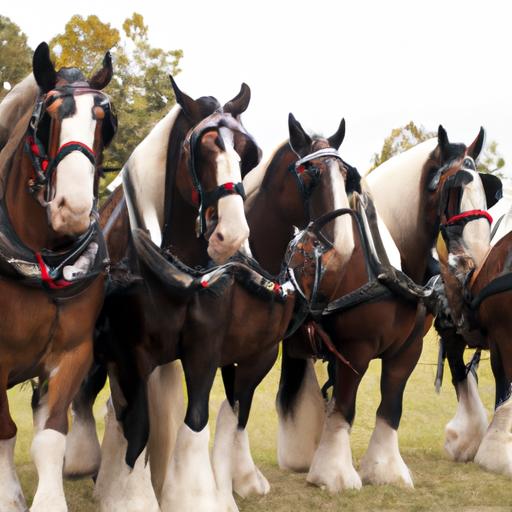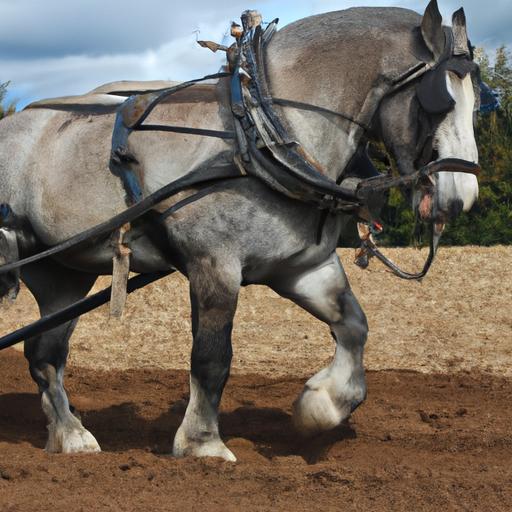Discover the incredible versatility of work horse breeds in agriculture, logging, and carriage industries. Uncover their vital role in shaping our world.
Introduction

When it comes to hard work, dedication, and unwavering strength, work horse breeds stand tall as the unsung heroes of our history. From plowing fields to hauling immense loads, these majestic creatures have played a vital role in shaping our civilization. In this article, we will delve into the definition, importance, and historical significance of work horse breeds, shedding light on their remarkable attributes and the impact they have had on various industries.
A. Definition and Importance of Work Horse Breeds
Work horse breeds are equine breeds specifically bred and trained to perform strenuous tasks that require immense power, endurance, and reliability. They are the backbone of industries such as agriculture, logging, and transportation, where their strength and unwavering work ethic are indispensable. These horses have been selectively bred over centuries to possess the physical and mental characteristics necessary for arduous labor, making them exceptional partners in human endeavors.
B. Historical Significance of Work Horse Breeds
Throughout history, work horse breeds have been instrumental in transforming societies and propelling progress. From ancient civilizations to the Industrial Revolution, these equine powerhouses have shouldered the burden of human labor, enabling the cultivation of vast lands and the development of infrastructure. They have pulled plows, hauled heavy loads, and even served in battles, showcasing their versatility and unwavering loyalty. The historical significance of work horse breeds cannot be overstated, as their contributions have shaped civilizations and left an indelible mark on our collective memory.
As we journey through the following sections, we will explore the defining characteristics of work horse breeds, delve into the most popular breeds, and uncover the industries where their strength and reliability are indispensable. Join me on this captivating exploration of these incredible creatures, and discover why work horse breeds are truly the unsung heroes of our past and present.
“Have you ever marveled at the strength of a work horse, pulling a heavy load effortlessly? Join me as we unravel the secrets behind these powerhouses and their historical significance. Let’s embark on a journey through time, where their unwavering dedication has shaped our world.”
Characteristics of Work Horse Breeds
Work horse breeds possess a remarkable set of traits that make them well-suited for the demanding tasks they undertake. Let’s delve into the key characteristics that define these extraordinary equines.
A. Strength and Endurance
Strength is the cornerstone of work horse breeds. Their robust physique, developed through generations of selective breeding, allows them to tackle heavy loads and perform arduous tasks with relative ease. These horses possess powerful muscles, strong bones, and a sturdy frame that enable them to exert tremendous force and pull heavy equipment.
Coupled with their strength, work horse breeds exhibit exceptional endurance. Endowed with an impressive cardiovascular system, they can sustain prolonged periods of exertion without succumbing to fatigue. Whether it’s plowing fields for hours or pulling a carriage over long distances, these horses possess an unmatched stamina that allows them to persevere through the most challenging of tasks.
B. Size and Build
Work horse breeds are renowned for their impressive size and build. Towering above other horse breeds, these giants command attention with their sheer presence. With an average height ranging from 16 to 19 hands (64 to 76 inches), they exude an aura of strength and power.
Their build is equally remarkable. Work horses have broad chests, strong backs, and well-developed hindquarters, which contribute to their ability to generate immense pulling power. Their muscular physique is complemented by sturdy legs and hard hooves, ensuring stability and resilience even in rugged terrains.
C. Temperament and Trainability
In addition to their physical attributes, work horse breeds possess a temperament that sets them apart. Known for their calm and gentle nature, these horses exhibit a docile disposition that makes them highly trainable. Their willingness to learn and work in harmony with their handlers is a testament to their intelligence and adaptability.
Their trainability is further enhanced by their innate desire to please, making them ideal partners for various tasks. Whether it’s responding to commands, adapting to new environments, or working collaboratively with other horses, work horse breeds showcase a remarkable ability to excel in diverse settings.
“Ever wondered what makes work horse breeds stand out in terms of their characteristics? Let’s uncover the secrets behind their immense strength, impressive size, and gentle temperament. Join me as we explore the traits that make these equines true powerhouses.”
Popular Work Horse Breeds
When it comes to work horse breeds, several magnificent breeds have captured the hearts and admiration of horse enthusiasts worldwide. Let’s explore three of the most popular work horse breeds and discover their unique characteristics, rich history, and versatile usage.
A. Percheron
-
Physical Description: The Percheron, originating from France, is an imposing breed known for its muscular build and impressive height. Standing between 16 to 17.3 hands high, these horses exhibit a compact and strong structure. Their dense, silky, and predominantly grey or black coats exude an air of regality.
-
History and Usage: The Percheron breed has a remarkable history rooted in French agriculture. Originally used for war purposes, they transitioned into agricultural work in the 19th century, where their strength and stamina were harnessed for plowing fields and pulling heavy loads. Today, Percherons are still utilized in various industries, including forestry, parades, and even as elegant carriage horses.
B. Clydesdale
-
Physical Description: Hailing from Scotland, the Clydesdale breed is instantly recognizable with its striking appearance. These horses are known for their immense size, standing between 16 to 18 hands high, and their feathered lower legs. Their coats can vary in color, ranging from bay to chestnut, while their white facial markings and abundant mane and tail add to their majestic aura.
-
History and Usage: Originally bred to work in the fields of Clydesdale, Scotland, these horses were highly valued for their strength and ability to pull heavy loads. In addition to their role in agriculture, Clydesdales gained popularity as brewery horses, symbolizing iconic brands. Today, they are prominently featured in parades, exhibitions, and used for promotional purposes, showcasing their beauty and charm.
C. Shire
-
Physical Description: The Shire, originating from England, is the largest of all the work horse breeds, standing at an impressive 17 to 19.2 hands high. Their muscular build, feathered lower legs, and broad hooves give them a commanding presence. Shires are commonly seen in shades of black, brown, or grey, with a thick, flowing mane and tail.
-
History and Usage: With a history dating back to medieval times, Shires were bred to serve as warhorses, carrying knights into battle. As agriculture evolved, Shires transitioned into working the fields and pulling heavy carts. Despite their declining numbers, these gentle giants are still appreciated for their strength and grace, often seen in shows, parades, and as carriage horses in tourist destinations.
“From the robust Percheron to the majestic Clydesdale and the towering Shire, these popular work horse breeds embody strength and grace. Join me as we delve into their physical attributes and uncover the fascinating history behind their usage in various industries.”
Training and Care for Work Horse Breeds
Work horse breeds are not only known for their physical capabilities but also for their remarkable trainability and resilience. Proper training and care are essential to ensure their well-being and optimize their performance. In this section, we will explore the key aspects of training work horse breeds and providing them with the care they deserve.
A. Basic Training Techniques
Training work horse breeds requires patience, consistency, and a deep understanding of their unique personalities. Establishing a strong foundation through basic training techniques is crucial for their success in various work environments. From teaching them to respond to basic commands and cues to familiarizing them with different equipment and tasks, trainers must employ gentle and positive reinforcement methods. This builds trust and cooperation between the horse and handler, setting the stage for a harmonious working relationship.
B. Proper Nutrition and Exercise
To maintain optimal health and performance, work horse breeds require a balanced diet and regular exercise. Feeding them high-quality forage, such as hay and pasture, supplemented with essential nutrients, ensures their nutritional needs are met. Additionally, providing them with sufficient exercise helps keep their muscles strong and maintains their overall well-being. Regular turnout in a spacious paddock or pasture allows them to move freely and engage in natural behaviors, promoting both physical and mental health.
C. Health and Veterinary Care
Just like any other animal, work horse breeds need regular veterinary care to stay healthy and prevent potential ailments. Routine vaccinations, dental check-ups, and deworming are essential to safeguard their well-being. Regular grooming, including hoof care and coat maintenance, not only enhances their appearance but also helps identify any potential health issues. Additionally, providing them with a comfortable and clean living environment, free from hazards, promotes their overall health and reduces the risk of injuries.
“Ensuring the well-being and performance of work horse breeds requires a holistic approach. Let’s explore the fundamental training techniques, nutritional needs, and vital veterinary care necessary to keep these magnificent creatures thriving. Together, we can ensure their welfare and appreciate the hard work they put into serving us.”
Conclusion
In conclusion, work horse breeds continue to be the backbone of various industries, embodying strength, endurance, and unwavering dedication. From their historical significance to their indispensable role in modern-day endeavors, these majestic creatures have left an indelible mark on our world.
The importance of work horse breeds cannot be overstated. Their contributions to agriculture and farming have allowed us to cultivate vast lands and ensure food security. In the logging and forestry industry, their sheer power and agility enable the transportation of heavy timber, shaping our landscapes and providing resources for construction. Additionally, in the realm of carriage and amusement rides, work horse breeds add a touch of elegance and nostalgia, captivating our hearts with their grace and beauty.
To ensure the well-being of work horse breeds, proper training and care are essential. Basic training techniques, coupled with a balanced diet and regular exercise, contribute to their overall health and longevity. Veterinary care plays a crucial role in detecting and preventing any potential health issues, ensuring that these magnificent creatures can continue to serve and inspire us.
At Horsemasterypro.com, we acknowledge and celebrate the remarkable work of these equine powerhouses. Their unwavering strength and reliability have earned them a special place in our hearts and history. Let us continue to appreciate and honor the legacy of work horse breeds, recognizing their vital role in shaping our world.
“As we bid farewell to this journey through the world of work horse breeds, let us remember their tireless efforts and the impact they have had on our civilization. Join us at Horsemasterypro.com as we continue to celebrate and cherish these incredible creatures, ensuring their legacy lives on.”


